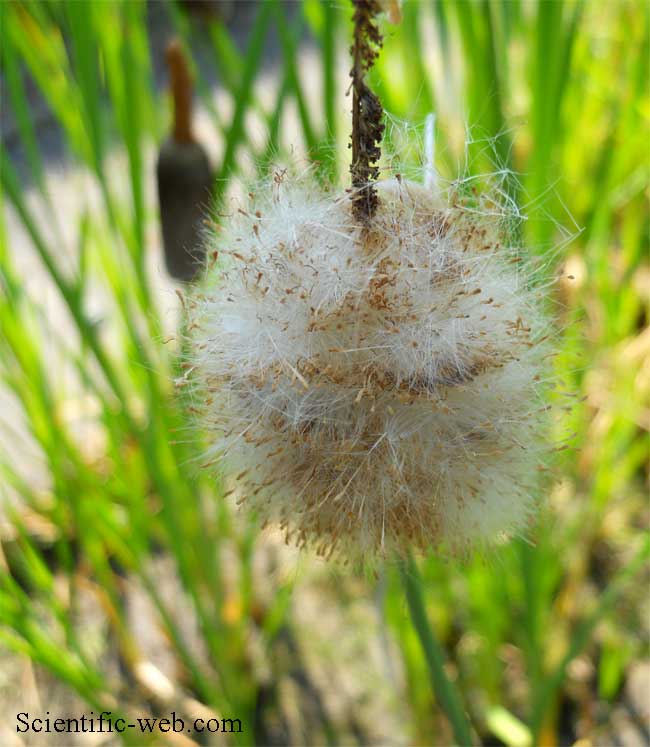
Typha minima, Photo: Michael Lahanas
Classification System: APG IV
Superregnum: Eukaryota
Regnum: Plantae
Cladus: Angiosperms
Cladus: Monocots
Cladus: Commelinids
Ordo: Poales
Familia: Typhaceae
Genus: Typha
Subgenus: T. subg. Rohrbachia
Species: Typha minima
Name
Typha minima Funck, Bot. Taschenb. Anfänger Wiss. Apothekerkunst 5: 187. 1794.
Synonyms
Homotypic
Rohrbachia minima (Funck) Mavrodiev, Bot. Zhurn. (Moscow & Leningrad) 86(9): 121. 2001.
Heterotypic
Typha angustifolia var. minor L., Sp. Pl. ed. 2: 603. 1762.
Typha angustissima Griff., Itin. Pl. Khasyah Mts.: 342. 1848.
Distribution
Native distribution areas:
Continental: Europe
Regional: Middle Europe
Austria, Czechoslovakia, Germany, Hungary, Switzerland.
Regional: Southwestern Europe
France.
Regional: Southeastern Europe
Albania, Greece, Italy, Romania, Yugoslavia.
Continental: Asia-Temperate
Regional: Siberia
Altay.
Regional: Middle Asia
Kazakhstan, Kirgizstan, Turkmenistan, Tadzhikistan, Uzbekistan.
Regional: Caucasus
North Caucasus, Transcaucasus.
Regional: Western Asia
Afghanistan, Iran, Iraq, Turkey.
Regional: China
China South-Central (Hubei, Sichuan), Inner Mongolia (Nei Mongol), Manchuria (Heilongjiang, Jilin, Liaoning), China North-Central (Gansu, Hebei, Shaanxi, Shandong, Shanxi), China Southeast (Henan), Xinjiang.
Regional: Mongolia
Mongolia
Continental: Asia-Tropical
Regional: Indian Subcontinent
Pakistan.
References: Brummitt, R.K. 2001. TDWG – World Geographical Scheme for Recording Plant Distributions, 2nd Edition
References
Funck, H.C. 1794. Hoppe Bot. Taschenb. 118, 187.
Govaerts, R. et al. 2020. Typha minima in World Checklist of Selected Plant Families. The Board of Trustees of the Royal Botanic Gardens, Kew. Published on the internet. Accessed: 2020 Jan 2. Reference page.
Vernacular names
čeština: Orobinec nejmenší
Deutsch: Zwerg-Rohrkolben
dolnoserbski: Mała rogož
English: dwarf bulrush
suomi: Pikkuosmankäämi
hornjoserbsce: Mała rohodź
Nederlands: dwerglisdodde
polski: Pałka drobna
Typha minima, common name dwarf bulrush or miniature cattail or least bulrush, is a perennial herbaceous plant belonging to the Typhaceae family.[3]
Description
The biological form of Typha minima is hemicryptophyte hydrophyte, meaning that they are plants with submerged overwintering buds, adapted to living in aquatic environments. Vegetative propagation takes place by means of a short 5 to 8 millimeters thick rhizome, that grow up to 20 cm deep in the ground.
Typha minima is the smallest of the cattails. It reaches on average 30–80 centimetres (12–31 in) in height,[4] with a maximum of 140 centimetres (55 in). The stem is erect and simple. The leaves are blue-green, linear, very narrow and not shiny. They reach up to 30 centimetres (12 in) in length and 1–3 millimetres (0.039–0.118 in) in width.
Close-up of a seed spike of Typha minima
These plants are monoecious, with the male and female reproductive structures borne on the same plant but packed into two separate inflorescences. The minute flowers are unisexual and wind-pollinated. Male (staminate) flowers are yellowish, while female (pistillate) flowers are greenish. The female inflorescence is brownish, ellipsoid, 2–5 centimetres (0.79–1.97 in) long, with an hairy rachis after the fall of the flowers.[4] It is separated from the male inflorescence by a naked stem section, about 1 centimetre (0.39 in) long. The male inflorescence is thinner and longer, at the top of the vertical stem.[4] The female flowers have one stalked ovary, surrounded by a thick fringe of hair. The three individual stamens of the male flowers are surrounded by just a few hairs. At the end of blooming the male flowers disperse, leaving the top of the stem naked, while the female inflorescence turns into a brown round seed spike. The main flowering period lasts from May through June.[4] Another flowering period may occur in August.
Distribution
This rare plant is widespread in temperate Europe and Asia. The distribution is limited to the rivers of the Alps and the Apennines and to the Balkans, the Danube region and the mountains of central Asia.
Habitat
Typha minima is a light-loving plant and cannot tolerate shade. It grows on periodically flooded banks of slow flowing, cool and pure waters, along lake margins, in marshes, ponds and swamps, at an altitude of 0–1,000 metres (0–3,281 ft) above sea level.[4]
References
IPNI Plant Name Query Results for Typha minima, The International Plant Names Index, retrieved 2011-09-27
The Plant List, Typha minima
Hoppe, David Heinrich. Botanisches Taschenbuch 5: 187. 1794.
Pignatti S. - Flora d'Italia – Edagricole – 1982. Vol. III, pag. 634
Plant Finder
Retrieved from "http://en.wikipedia.org/"
All text is available under the terms of the GNU Free Documentation License

